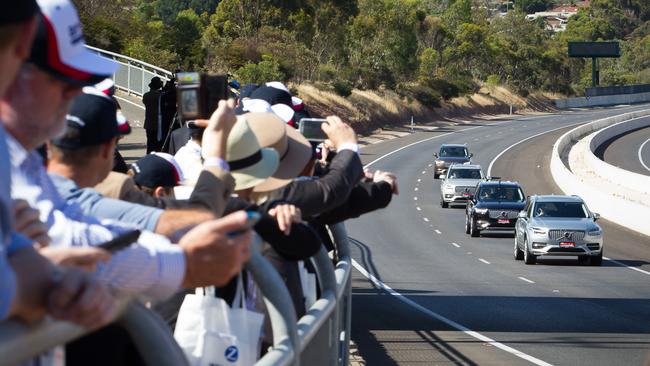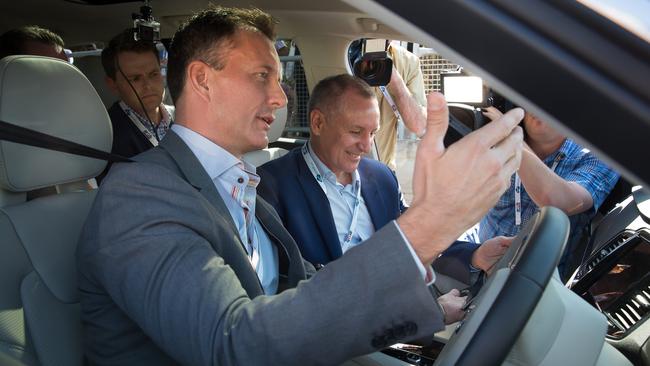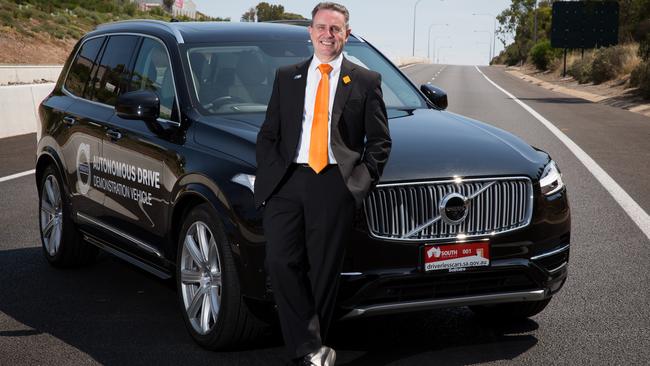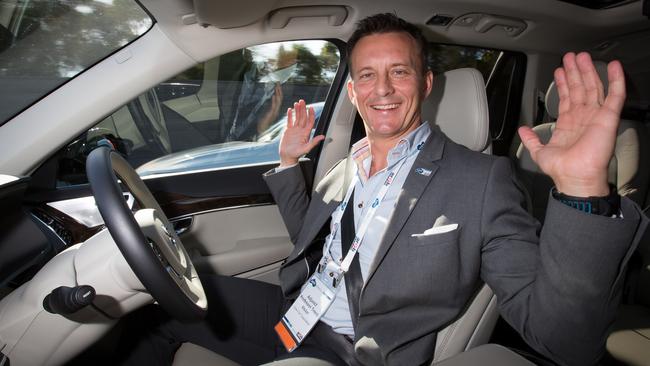Driverless cars closer as Adelaide test shows how it would work
A driverless car travelled on an Adelaide motorway yesterday. This will one day make your commute far more productive.
Commuters on gridlocked expressways will be among the first beneficiaries of driverless car technology, which took a leap forward at the weekend.
In an important moment in automotive development, a Volvo XC90 drove along a blocked section of Adelaide’s Southern Expressway. A driver was at the controls but not steering, nor was he using the brakes or the accelerator.
A driverless future faces enormous challenges. There’s guaranteeing safety, reworking insurance liability, collision avoidance, and upgrading road infrastructure. Yet at Saturday’s demonstration it became clearer how driverless vehicles may roll out in Australia.
360 degree video of the historic driverless vehicle journey with South Australia Premier Jay Wetherill. Drag your cursor across the video to see the car and its participants from all angles. You will need Google Chrome or Firefox to view it.
It seems we’re not going to see driverless vehicles suddenly manifest around the suburbs, taking kids to school or doing trips to the local supermarket.
Driverless cars are the next evolutionary step from semi-autonomous cars that already have features such as adaptive cruise control, assisted parking, pedestrian and collision avoidance and lane departure warning capabilities. The difference is you take your hands off the wheel with increasingly sophisticated versions of this technology.
And cars won’t travel in driverless mode everywhere. Expressways and shuttle services are a likely starting point.

If roads are certified to benefit the largest numbers possible, gridlocked commuter corridors such as Sydney’s M4 and Melbourne’s Eastern Freeway would be likely candidates.
Volvo senior technical leader crash avoidance Trent Victor said commuters would drive to an expressway and then take their hands off the wheel. “You give your control to the vehicle, and that’s your commute to work, and you’re free to do something else.” He said life would be more meaningful than sitting in traffic.
South Australia Premier Jay Weatherill said he expected Volvo’s technology to eventually filter through to other manufacturers.
“The great example of that is ABS braking, that was in the top-of-the-range Mercedes at the start, then it spread into every car and now it is a standard feature. That’s the tradition of new technology in the car industry.”

Mr Weatherill said he was keen for a social and ethical discussion around driverless car use.
“There are lots of complicated issues about both civil and criminal liability and insurance associated with it, where those liabilities fall and how they need to be managed. There’s a lot of work to be done,” the Premier said.
On Saturday, the driverless car invoked an adaptive cruise control mode, where it calculated its speed based on the car in front. When that car changed lanes and the road was clear, the driverless car automatically increased speed. Several sensing systems combined to ensure it stayed in its designated lane.
Mr Weatherill said he didn’t feel unsafe while travelling in the demonstration car.
“The truth is we put our life in the hands in technology every day of the week. If you’re on a plane trip or using an elevator, nobody really stops to think that there could be some catastrophic failure, and we get relaxed. It’s just that it’s a little confronting when you first hear about it.”

Australian Road Research Board group managing director Gerard Waldron said shuttle services and convoys would also benefit, among others.
“You’ve got a 40 per cent reduction in the cost of running a truck (with no driver),’’ he said.
“But it goes further. If you don’t have a driver, you don’t need a cab, so you can take a ton of payload over the front axle where you’ve taken the cab off.
“Once the economic benefits are demonstrated and the technology is proven, the uptake will be quite quick.”
Professor Victor said Volvo would provide 100 vehicles to customers in Sweden for its 2017 pilot study at Gothenburg, the city of its headquarters. Volvo was accepting legal liability for the cars, in what will be a showcase of how technology might work elsewhere.
Volvo Car Australia managing director Kevin McCann said certain sections of Gothenburg had been certified to be autonomous enabled. “We presume there are all sorts of unimaginable scenarios that could occur on a road with mixed drivers and autonomous and we need to understand what they are. I think Australia will be a fairly early adopter in a world context.”




To join the conversation, please log in. Don't have an account? Register
Join the conversation, you are commenting as Logout